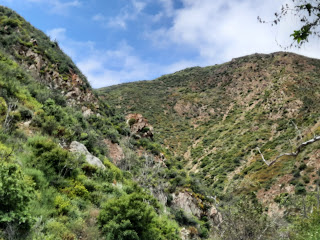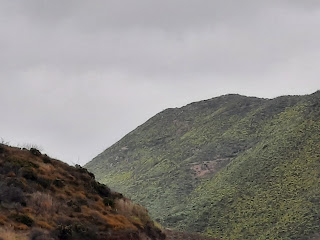Week 4, 6/12/23 to 6/15/23
I think this is the week where I stepped out of my comfort the most. Facilities week. I’ve never done manual labor jobs like landscaping and renovation work so it was definitely an abnormal experience for me. Monday and Tuesday I worked with the roads and trails team, Thursday I was with buildings and utilities. I had a separate adventure on Wednesday, which I’ll get to later.
The roads & trails team likes to start bright and early, so I arrived at the maintenance office at 6:30 AM. Tara Hallman, the crew lead, was there to greet me. She took me a little further up the hill to the toolshed and showed me where they stored the equipment we would need for the day. Tara walked me over to this massive storage container and handed me a weed wacker; I’ve never used one before so I was taken aback a bit. I had to wear a harness that hooked onto the wacker because I wasn’t used to its weight. With the weed wackers gassed up, we headed out to Zuma Canyon where we spent the whole day. In the parking lot I got introduced to the other team members I’d be working with. There was Rhyse, the assistant crew leader, Nick, Devan and Ben. We did some group stretching before heading out to do some weed wacking. Tara, Nick, Devan and Ben hiked about a mile down the trail to finish where they left off their last shift, while Rhyse and I stayed at the trailhead to work on the entrance to the trail. We were using the weed wackers to mow down the overgrown brush and widen the trail so that the visitors can have easier access to them.
Once we were done, Rhyse and I hiked out to meet the others. Tara showed me how the trails crew claims a section of the trail to work on. You drop your weed wacker next to another crew member’s pack, then you walk about ten or twenty feet and drop your own pack. The other crew member’s pack represents your starting point, your own pack marks your ending point as well as the starting point for another crew member. We got so much done that we actually finished the trail a little early. We hiked back to the trucks, cleaned the weed wackers and took our final break for the day at Solstice Canyon.
I was still with the Trails team today. We did our usual routine of gassing up the weed whips (even though we didn’t use them), loading the mowers onto the trucks and group stretching. Today we tackled Rancho Sierra Vista and Satwiwa. The trails needed mowing, so we split up into two teams. Tara, Ben and Devan took one side of the Satwiwa Loop trail while Rhyse, Nick, Jenna and myself did the other side of the loop and the Old Cabin trail. One person would steer the mower and the others would use these long, flat tools with prongs to push bush into the path of the mower and clear big rocks from its path. On my team, Nick steered the mower the whole day, so the rest of us got busy with clearing rocks. After lunch my team returned to where we dropped our equipment and started on the Old Cabin Trail, where we worked for the rest of the day.
Wednesday was a big change from how the rest of week had one. I was back with the LE Rangers to participate in a use of force refresher. VRP didn't start as early as today, so I reported to the community room next to headquarters at 8 AM. All of the LE Rangers were in attendance, except for Ranger Braten but he would be joining us later. We had two special guests: a Fish & Wildlife Officer and Conner, who works at the stables at Rancho Sierra Vista. Ranger Cooper and Ranger Johnson were the instructors for this training.
We got started as soon as Ranger Cooper performed a safety check on everyone. We began with a discussion about the legal standards of using force as well as the strained relationship between police and the general public due to excessive force. Ranger Johnson reminded us that we must react to the threat of violence and always be one step above the level of aggression we are facing. Ranger Cooper also discussed the Graham vs. Connor case that set the use of force standards for law enforcement today. The Graham factors are a list of justifications that law enforcement officers use to assess if using force is reasonable. It’s been condensed into an acronym called SIRF, which stands for seriousness of the crime, immediacy of the threat, resisting arrest, and fleeing the scene.
Once group discussion was over we got into some roleplaying drills. For the first part of the drills I watched just so I could get a sense of what would be expected. These scenarios were fully scripted so we could train our subconscious to build mental files so we can respond appropriately in a real situation. The scenarios were between an officer and a suspect. Half the Rangers played as officers, the other half as suspects. The scenarios we went through involved using deadly force, intermediate weapons and arresting your suspect. Then it was my turn to be an officer, and Ranger Spraggins was my suspect. I’ll admit I was a little awkward in the first couple scenarios, but I slowly got used to it. I remember having trouble drawing the red gun from my holster, Ranger Spraggins kept having me practice and it slowly got easier, but it wasn’t as fluid as the other Rangers.
After lunch we went to the stables at Rancho Sierra Vista to do some unscripted scenarios. The Rangers ran a few scenarios about approaching a vehicle and some of the more strategic ways to do so. Then we used Connor to be our suspect in two unscripted scenarios. The first scenario I was the cover officer for Ranger Preece, meaning he led the contact while I recorded information and kept in communication with dispatch. Ranger Preece made it a bit easier on me since this was my first scenario and did most of the talking, even though in real life the contact officer is always subject to change. I did my second scenario with Ranger Braten, who was my cover officer. I have to say, I was really nervous and terrified I would mess up. Ranger Cooper assured me that I would do well and if I was going to mess up, this was the place to do so since this was a sterile environment and I could learn from my mistakes. When the scenario began, I initially called out to the suspect to get his attention, but I wasn’t sure how to react when I noticed he was holding a knife. Thankfully, Ranger Braten noticed my hesitation and took over. We drew our red guns and “shot” the suspect when he started coming towards us. Ranger Cooper told me that I did very well and reacted appropriately, the only thing I forgot to do was to announce police presence. Overall, I performed very well in my first scenario. I surprised myself because I didn’t think I would do as good as I ended up doing.
To finish out my facilities week I was with Buildings & Utilities. I arrived at 6 AM and was greeted by Derek, the supervisor. He introduced me to Pete and Tim, who I’d be with today. First, Pete took me to Peter Strauss Ranch to empty trash cans. While we were there, Pete showed me a homeless man who was camping out behind the public restrooms, he was laying in a sleeping bag and writing in a journal. Because camping is forbidden in the park, I had to call it in. It was my first time using the radio for such purposes, so I was nervous and had to rehearse what I would say in my head a few times. I made the call and gave a brief description of the man for dispatch to use. There were no law enforcement Rangers on at the time so dispatch held onto the description for when someone came in service. Pete and I went back to Diamond X in the meantime. At 7 AM, Ranger Cooper called in service and responded to my call. She later told me that the man did not want to speak with her and left Peter Strauss Ranch.
Pete, Tim and I ventured out to Circle X Ranch to work on park housing. The housing we worked on was the neighboring unit to the one Ranger Braten lives in; it needed to be renovated for its next resident. The dry walls had been put up, they just needed to be sanded and mudded. Pete and Tim were lining the corners and the doorways with metal strips, I did some sanding but I became addicted to mudding. The mud needs to be smooth, even and thin. I found great joy in smoothing out the mud, I compared it to frosting a stale cake. Pete and Tim thought I did very well with the mudding and that it was perfect. I mudded every corner and doorway, it took me a long time, but quality was key.






Comments
Post a Comment